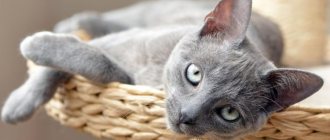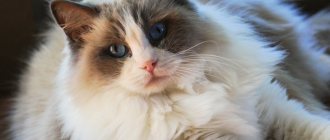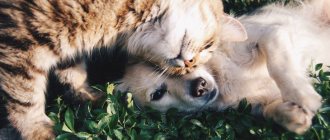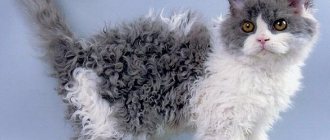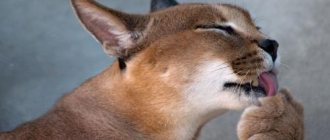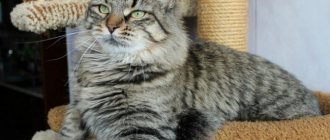Today, very few cats are purebreds, and unlike the thousands of dog breeds, there are fewer than 100 cat breeds. The International Cat Association recognizes 71 breeds, the Cat Fanciers' Association lists only 44 breeds, and the International Cat Federation has the shortest list with only 43 breeds.
Before a breed is included in one of the registers, it can take a long time to ensure that it is genetically stable and meets standards. However, as rare as it may be, new breeds are being recognized and there are many breeders working to develop new and unusual breeds. Below are 15 new breeds, some of which have only recently been accepted as standard, and some of which have not yet received official recognition.
Highlander
- Lifespan: 10-15 years
- Temperament: affectionate, gentle, intelligent, sociable, energetic
- Color: Various colors, including spotted patterns
- Height: 25.4-40.6 cm
- Weight: 4.5-9 kg
- Comparable breed: Maine Coon, Scottish Fold
Highlanders are still an experimental cat breed. However, work on its creation began back in 2004 after crossing two hybrid breeds - the desert lynx and the jungle curl. The original name for this breed was Highland Lynx before it was changed to Highlander in 2005.
The cats are robust, muscular, and have extra toes ( polydactyl paws ) and unique curved ears reminiscent of those of wild cats. Highlanders are very energetic cats, so they require a little more care and active play to release excess energy.
Despite their apparent aloofness, Highlanders are affectionate and people-oriented, making them excellent family pets. Interestingly, these cats love water and don't mind getting wet at all; something unheard of in the cat world. They are also intelligent, easy to train, love attention, and often display their acrobatic abilities to impress others.
Now the Highlander is recognized by the International Cat Association as a new breed, so it will soon be able to take advantage of the opportunity to take podiums in the exhibition and championship arenas.
Serengeti
- Lifespan: 10-15 years
- Temperament: active, lively, affectionate, loyal, sociable, vocal
- Colour: Striped, silver, golden, grey, with spots and leopard markings
- Height: up to 60 cm
- Weight: 6.8-10 kg
- Comparable breed: Serval
Unlike the Highlander, the Serengeti can already officially compete in championships because they have received the appropriate status from the International Cat Association. The Serengeti was developed by crossing the Bengal and Oriental Shorthair breeds.
This cat began to be bred in the 1990s in an attempt to produce a domesticated wild serval . The Serengeti has a spotted body, long legs and large ears. The male is usually larger than the female. These felines are highly athletic and are known for their loyalty, energy, and agility. They are able to create strong bonds with people.
Ragdoll
The Ragdoll breed is especially popular in Europe and North America. People called this cat a rag doll. The fact is that she has very weak muscle tone. If you take a ragdoll in your hands, you can feel how it literally spreads. This is the only cat that needs to be protected from jumping from heights, as this is fraught with injuries, but the ragdoll loves to play and run.
Animals of this breed are very attached to their owners, almost like a dog. If you don't pay attention to them, they become sad and sad.
The Ragdoll has long, strong legs and fur that varies in length and fluffy. This large cat grows slowly and reaches its maximum size only at four years of age. Males are much larger than females and weigh up to 9 kg.
American Curl
- Lifespan: 9-13 years
- Temperament: Athletic, outgoing, friendly, family-oriented, sociable
- Color: white, black, blue, silver, red, lilac, chocolate, gold, cream, tortoiseshell
- Height: up to 30 cm
- Weight: 3.6-5.4 kg
- Comparable breed: Korat, Nibelung
The American Curl is the result of a spontaneous natural mutation. The breed originated in 1981 in Southern California. They are medium-sized cats with an athletic build, long tails and folded-back ears with long tufts of fur, which gives them their name.
American Curls not only look athletic, but also have significant athletic qualities. They will love climbing cat trees and perches, and they won't shy away from the highest places in the house. They are passionate about climbing and love to play even in old age . The American Curl is unlikely to want to curl up on your lap, but it will enjoy being close to you. These cats are sociable and people-oriented.
Exotic Shorthair
These cats are very similar to Persians: massive build, round head, small ears, huge round eyes and an incomparable, “sweet” expression on their face. The character of exotics is just as pleasant, calm and good-natured. What's the difference? Fur length. In exotics it is short, but no less thick. The standards allow almost all colors.
Exotics are so good that you can’t believe their origin is random. And this is exactly so. In the middle of the last century, US breeders improved the American Shorthair type by mating with Persians. The offspring were charming, but did not at all live up to the breeders' expectations. After a long discussion, it was decided to breed a new breed.
Aphrodite
- Lifespan: 12-15 years
- Temperament: sociable, calm, attention-seeking, loving, affectionate
- Color: all colors except lilac, mink, chocolate, fawn and point
- Weight: 5-11 kg
Aphrodite, also known as the Cyprus cat, is a giant, short-haired, energetic and playful cat breed. Experts believe that this cat breed originated in the mountainous regions of Cyprus and, due to its large size, could easily hunt large predatory animals.
The cats are large, have long hind limbs and luxurious, thick fur , which help them climb and adapt to mountain conditions. Due to their enormous size, Cyprus cats take up to three years to reach full size.
Although Cypriot cats have been around for almost 10,000 years, it was only in 2012 that the Aphrodite giant cat breed was officially recognized by the World Cat Federation. There are still wild populations of this breed in Cyprus. They are often described as cat-like dogs when it comes to relationships with their owners.
Rating of cat breeds
The main guideline when analyzing descriptions of various cat breeds were reviews of their owners and animal care specialists - veterinarians, groomers, etc. An important point was the affordability of kittens.
The analysis was carried out in several directions:
- History of appearance - where and by whom it was bred, with whom it was crossed, when it happened;
- Appearance - color, thickness and length of fur, shape of the muzzle, eye shade, etc.;
- Body build – weight, muscles, height at the withers, massiveness and height of the paws;
- Character – playfulness, obedience, ability to get along with children and other animals, ability to tolerate loneliness;
- Dietary requirements - what kind of food and how often should be fed, tendency to obesity;
- Health – resistance to various diseases, frequency of visits to veterinarians, need for vaccination, life expectancy;
- Features of care - how often it needs to be brushed, whether the hair sheds and falls off, whether the animal tolerates bathing easily and how many times it should be washed.
Very important when preparing the TOP 10 cat breeds was the combination of ease of cat care, undemanding diet, calm and balanced character, beautiful appearance and good health.
The best scratching posts for cats
Cheeto
- Lifespan: 12-14 years
- Temperament: affectionate, sociable, intelligent, gentle, friendly, energetic, curious
- Color: spotted in silver and brown tones, marbled in brown and blue tones, snow with spots and marbled patterns
- Height: 25.4-35.6 cm
- Weight: 3.6-5.4 kg
- Comparable breed: Bengal cat, Ocicat
The Cheeto was developed by crossing an Ocicat and a Bengal cat. The breed was first bred in 2001. Breeder Carol Drymon of Wind Haven Exotics hoped to create a domestic breed that resembled a wild cat. It was officially accepted in 2004.
These cats are very affectionate, sociable and love human company. They are also energetic and playful climbers. They enjoy hunting toys and climbing cat trees. After active games, they happily rest on the laps of their owners.
Chito is quite noisy and loud . He will let you know when you need to feed him, take him for a walk, or just talk to him. Be prepared for destructive behavior if the kitten becomes bored or lonely.
Minskin
- Lifespan: 12-14 years
- Temperament: good-natured, friendly, intelligent, curious
- Color: all color variations
- Height: 17.8-20.4 cm
- Weight: 1.8-2.8 kg
- Comparable breed: Balinese cat, Somali cat, American Curl
The Minskin is a new breed of cat, bred in Boston in 1998. The first cat was born in July 2000, and by 2005 there were already 50 species of Minskins. Currently, the International Cat Association monitors the development of the breed.
Paul McSorley created the breed by crossing a Munchin with a Sphynx and refined it using a Devon Rex and a Burmese. The breeder intended to create a short-legged cat with fur on the limbs (tail, legs, nose, ears and face) with color variations found in breeds such as Siamese cats. Minskin is described as a corgi from the cat world , as he has sparse hair on his body and a hairless belly.
Minskins are affectionate, sociable and playful. But despite its energy, this breed cannot reach the physical heights of other cats due to its short, stocky legs.
British Shorthair
A strong, compact, massive body, a thick, double plush coat, an important expression on a thick-cheeked muzzle and huge round eyes of an invariably bright color - the British are simply the embodiment of thoroughbred! And if we add to this pleasant appearance a calm, self-possessed character and the ability to easily endure a rather long (all day) absence of the owner, then the reason for the popularity of the British for almost a century is obvious.
The history of the breed began in the 70s of the 20th century, simultaneously with the emergence of felinology - the science of cats, which appeared thanks to the English enthusiast H. Ware. The ancestors of the breed were local cats of Great Britain, and cats brought by the Roman conquerors, and representatives of other breeds. Like many others, the breed almost disappeared during the Second World War, but it was restored. Of course, the British are one of the most popular purebred pets.
LaPerm
- Lifespan: 10-15 years
- Temperament: gentle, affectionate, mischievous, curious
- Coloring: various combinations of colors and patterns
- Height: 15.2-25.4 cm
- Weight: 2.3-3.6 kg
- Comparable breed: Somali cat, Japanese bobtail
LaPerm gets its name from the incredibly bouncy curls on the body . The first cat of this breed appeared in The Dalles, Oregon, in 1982, when a brown tabby barn cat named Speedy gave birth to a litter. One of the kittens was different from the rest: he was bald, with striped markings on his skin and wide-set ears. Despite the fact that the kitten was hairless at birth, as it grew older the fur became curly.
These little cats are smart, mischievous and follow their person everywhere without being overly intrusive. LaPermas are friendly to strangers and other cats and dogs. The International Cat Association recognized this breed in 2002.
Munchkin
- Lifespan: 12-15 years
- Temperament: sociable, curious, playful, smart
- Coloring: any color and pattern combination
- Height: 17.8-20.4 cm
- Weight: 2.3-4.1 kg
- Comparable breed: Chartreux, Cornish Rex, Somali cat
The Munchkin was one of the breeds that helped create the Minskins, although it is also a new breed. This cat is responsible for the Minskin's short legs. The Munchkin is considered the original breed of dwarf cat . They arose from a natural mutation discovered in felines in the 1940s. However, it was only in 1983 that cat lovers began crossing them with other breeds.
Breeders officially introduced the breed to the public in 1991. Unfortunately, many cat registries refrain from recognizing the breed due to potential health concerns (short legs are the result of a genetic mutation, after all). Only the International Cat Association recognized the breed in 1995.
Tennessee Rex
- Lifespan: 14-16 years
- Temperament: affectionate, sociable, quiet
- Colour: orange-cream, red and white with satin effect
- Weight: 3-5 kg
The Tennessee Rex, discovered in 2004, is the result of a natural mutation. Franklin Whittenburg of Tennessee had a stray cat who once gave birth to kittens, two of which were unusual. Due to a genetic mutation, these kittens had curly, satiny fur. The International Cat Association recognized the Tennessee Rex as a breed in 2009, although they have never made it to the championship level.
The Tennessee Rex is a very loving cat that enjoys spending time with family members. She loves to cuddle and lie on your lap. They are quiet cats, although they can make a little noise when hungry. But keep in mind that they need time to adapt to their new environment.
1. The perspicacious cat Achilles is a fortuneteller
Achilles the cat is the main Russian football oracle.
Photo: Artem KILKIN
On the eve of the 2020 European Football Championship games, a whole army of fans was watching which of the two bowls marked with the flag of a particular country would decide to eat from the famous St. Petersburg cat from the Hermitage. The shaggy oracle performed well during the 2018 World Cup, predicting the outcome of seven out of nine matches, and predicted the outcome of matches during the Confederations Cup in 2017 and the 2018 World Cup. At the status games in the past year, Achilles’ superpowers, naturally, were not abandoned. And the result exceeded all expectations. Achilles predicted the outcome of eight Euro 2020 games and was wrong only once.
Napoleon
- Lifespan: 9-15 years
- Temperament: sociable, playful, flexible, gentle, active, energetic
- Coloring: all colors and patterns
- Height: 17.8-20.4 cm
- Weight: 2.3-4.1 kg
- Comparable breed: Munchkin, Persian cat
Also known as the Minuet, the Napoleon breed is a newly introduced species of dwarf cat. These felines are named after Napoleon Bonaparte due to their short stature.
Joe Smith created the breed in 1996 after crossing a Munchkin with a Persian cat. He later improved the breed using genes from exotic shorthair cats. The International Cat Association recognized this breed in 2011.
Napoleon is a loving, sweet and calm cat breed. She loves all family members and will easily communicate even with strangers. Napoleon can live happily with other cats and dogs. He needs a lot of active play, otherwise excess energy can negatively affect his behavior.
Ojos Azules
- Lifespan: 10-12 years
- Temperament: friendly, active, affectionate
- Color: all colors except solid white
- Height: 20.3-25.4 cm
- Weight: 4.1-5.5 kg
- Comparable Breed: Domestic Shorthair, Domestic Longhair
Ojos Azules have beautiful dark blue eyes; it is not for nothing that the name of this Spanish breed is translated as “blue eyes” . The appearance of the breed dates back to 1984, when a tortoiseshell cat named Cornflower gave birth to kittens with the same piercing eyes, which proves that breeders can continue to reproduce this strain. However, the gene that causes blue eyes does not appear to be reflected in the pet's coat pattern or color.
The International Cat Association recognized the breed in 1991, but the Ojos Azules remains a rare breed. This is caused by a genetic mutation that leads to defects in the skull. Thus, breeding is suspended, at least for the time being. However, some instances may still exist. These medium-sized cats are known to be friendly, sweet, and loving pets.
Toy bob
- Lifespan: 14-15 years
- Temperament: loyal, playful, charming, playful, intelligent, curious
- Color: any
- Size: no larger than a 3-6 month old kitten
The Toy Bob is one of the smallest cat breeds. However, unlike many toy breeds, it is not a miniature version of a larger breed. On the contrary, it is a unique breed with Russian roots .
The first documents about these cats were obtained in the 1980s by the Cat Fanciers Association. The Toy Bob is considered a loving, loyal, intelligent and sociable cat that will get along with all family members, including children and even dogs. In addition, the Toy Bob is a good climber and a cuddler.
Siberian
A muscular, rather large, strong-built cat in a fluffy coat with a breathtaking “collar” and tail, a proportional head, and a smart expression on her face is the pride of many breeders. In addition, Siberians have an excellent, cheerful and sociable character. In general, it is not surprising that the first experience of Russian breeders turned out to be more than successful: Siberians are popular all over the world.
There are numerous legends about Siberians. It’s as if their ancestors were the indigenous inhabitants of Siberia for hundreds of years. However, the breed was bred by breeders - residents of cities in the European part of Russia, and cats picked up on the nearest streets were selected for selection.
Peterbald
- Lifespan: 12-15 years
- Temperament: smart, affectionate, active, acrobatic, friendly, curious
- Coloring: many colors and patterns
- Height: 20.3-30.5 cm
- Weight: 3.2-6.3 kg
- Comparable breed: Sphynx, Oriental cat
The Peterbald is a Russian breed, first bred in St. Petersburg in 1994, which is how it got its name. The cat was obtained as a result of experimental breeding by Olga Sergeevna Mironova, who mixed the genes of the Don Sphynx and the Oriental Shorthair cat.
The most striking physical characteristic of the Peterbald is that it is hairless, although varying degrees of baldness occur. You might think that a hairless cat requires less time and effort to groom, but this is not true. Yes, she won't need brushing, but she will need weekly bathing. Peterbalds also need to eat more due to their faster metabolism .
The Peterbald is the closest thing to a dog as a four-legged companion. He will play, sit with you and even enjoy a good walk.
Toyger
- Lifespan: 10-15 years
- Temperament: affectionate, sociable, easy to train, intelligent
- Colour: red or brown with dark vertical stripes
- Height: 23-33 cm
- Weight: 3.2-6.8 kg
- Comparable breed: Bengal cat
The Toyger is a designer breed, which means that breeders deliberately designed its body markings. They set out to create a tiger-like domestic cat , and they certainly succeeded. But despite its resemblance to a tiger, this domestic cat is known for its affectionate disposition and loyalty to all family members of all ages, two-legged and four-legged.
These short-haired tabby cats were first bred in 1980. The International Cat Association recognized the Toyger in 2007, although other registries do not officially recognize the breed.
Siamese
A thin-legged, very stylish cat with a wedge-shaped, highly elongated head, large ears, short, “thin” fur, it is famous for its exceptional sociability, talkativeness and mobility. The ancestors of the Siamese came to Europe more than a hundred years ago from Thailand, captivating Europeans with their slenderness and amazing color-point color, named Siamese in honor of the breed. Modern Siamese have become much slimmer and look little like their ancestors. Of course, this is one of the most recognizable and popular breeds for decades.
Likoy
- Lifespan: 12-15 years
- Temperament: sociable, affectionate, active, friendly
- Color: black
- Height: 20.3-25.4 cm
- Weight: 2.7-5.5 kg
- Comparable breed: Sphynx
Lykoi is undeniably a werewolf, hairless and with pointed ears. People call it the "wolf cat" because of its thin, toned body and wedge-shaped head. This cat is generally hairless, although there is fur on some areas of the body. People sometimes confuse them with sphinxes, but in fact they have no genetic connection.
Currently, the Lykoi is considered an experimental breed , resulting from genetic mutations of domestic cats. These cats are friendly with family members, but they have retained some of the qualities of their wild ancestors. Lykoi is very active, enjoys the outdoors and still has a hunting instinct, so is not considered safe for small pets. These cats are also more reserved than other breeds, especially in new environments and with new people.
Based on materials from: www.petkeen.com
Maine Coon
The majestic Maine Coon commands respect even from serious men who are indifferent to pets and attend cat shows solely at the request of their children (or grandchildren). Of course: impressive size, a luxurious fur coat, a magnificent long tail (the Maine Coon’s nickname is “a tail with a cat”), large tassels on the tips of the ears and an important expression on the face cannot fail to impress. The standards allow many colors, with the exception of color point (Siamese).
This breed is one of the oldest bred by US breeders. Mentions of Maine Coons - large, shaggy and hardy farm cats - date back to the second half of the 20th century. However, the modern type was formed only in the middle of the last century.

